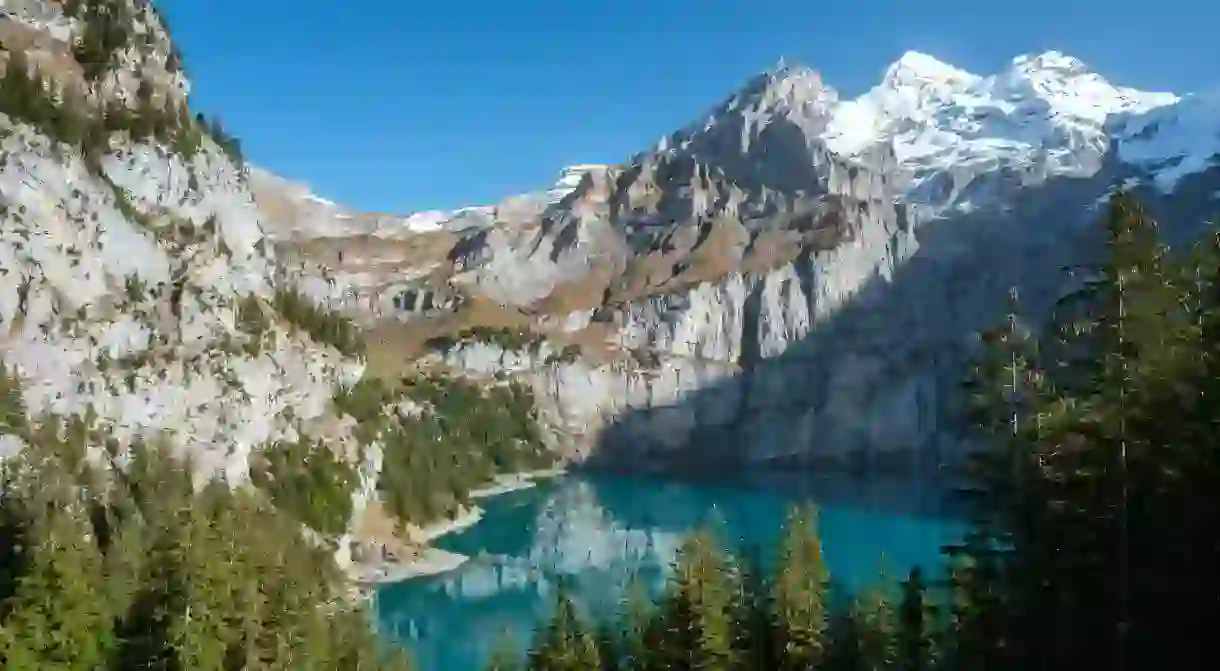18 Natural Wonders in Switzerland That'll Take Your Breath Away

For such a small country Switzerland, a land of mountains, is spoiled by its spectacular natural scenery. In almost any part of the country, you’ll be treated to view that will take your breath away, and leave a lasting memory. Here, discover the natural wonders that can be found in Switzerland.
Matterhorn
Hill Station

Renowned as the most photographed mountain in the world, the jagged tooth-like Matterhorn is a wonder to behold. At a dizzying 4,478-metres high it’s one of the tallest mountain in the Alps.
The Rhine Falls
Natural Feature
The Rhine Falls, Europe’s largest waterfall, is a wall of frothing white foam that thunders from afar as hundreds of cubic feet of water flow over it every single second. Even more impressive are the rocks at its centre which have somehow withstood its erosive power for centuries.
Lac Léman
Natural Feature

The largest lake in Switzerland, and in the Alps, Lac Léman (also known as Lake Geneva) curves for 73 kilometres from Geneva, on the western border with France, all the way along to the resort town of Montreux. Towering above it are the Alps, making for dramatic views along the breadth of the water’s edge.
Jungfraujoch
Train Station

Lauterbrunnen Valley
Natural Feature
This ancient glacial valley is 3 kilometres deep! Its distinctive U-shape makes it easy to imagine the massive glaciers that carved it from the surrounding mountains. Not to mention, a staggering 72 waterfalls line the valley.
Lake Lucerne
Natural Feature

Staubbach Falls
Natural Feature
Among the many waterfalls in the Lauterbrunnen Valley are the Staubbach Falls, the highest free-falling waterfall in Europe, where the water cascades from 300 metres high.
Lake Lugano
Architectural Landmark

Bordering with Italy, the glacial Lake Lugano is a lovely stretch of water that is named after the charming city of Lugano, in the Italian-speaking part of Switzerland. There are boat tours available for visitors, which offer gorgeous trips to places around the lake, including the wonderful historic village of Gandria. It is also notable for having such a large variety of fish, including crayfish, carp and catfish, as well as being the site of fossils dating as far back as the Triassic period. Recommended by Colette Lewis.
Aare Gorge
Natural Feature
Another glacier carved wonder is Aare Gorge, where the Aare River, fed by glacial run-off, cut through 200 metres of limestone leaving behind a 1.4 kilometre long gorge. Walking along the length of the gorge and running a hand along of the smooth surfaces gives a sense of the power of the natural forces that shaped the surrounding land.
Thunersee
Natural Feature

An Alpine lake situated in the heart of the Bernese Oberland, Thunersee is made especially picturesque by the magnificent mountains that surround it and the quaint villages along its banks. The town of Thun, from which the lake takes its name, is worth visiting in order to experience the grand castle and historical medieval Old Town. Also of note are the 12 beautiful churches that occupy the coastline, all dating back to the medieval period. Recommended by Colette Lewis.
Trümmelbach Falls
Natural Feature
Glacial flow from the nearby Eiger Glacier is responsible for the wonder that is the Trümmelbach Falls, a spectacular network of 72 underground waterfalls. It’s possible to follow the falls through a trail of bridges and tunnels.
Lake Constance
Natural Feature

Situated on the Rhine, and part of Germany and Austria as well as Switzerland, stunning Lake Constance is the third largest lake of central Europe. It contains several picturesque islands, including the lovely Bavarian Lindau. It is also interesting from a political perspective, since there is still debate about where the borders really lie between the three countries it links, and even today there are a number of disputes about which country has the right to fish within certain parts of the lake. Recommended by Colette Lewis.
Lac souterrain St-Léonard
Europe’s largest underground lake is found in Switzerland, along the Rhone valley. On a boat ride you can explore its eerily calm waters.
Oeschinensee
Other lakes may be larger, but few challenge the Oeschinensee in terms of beauty. Like a mirror, it reflects the surrounding mountain walls that surrounds it, making it perhaps the most photogenic lake in the Alps. One of the great glaciers from the last Ice Age, the Aletsch Glacier stretches for 23 kilometres and is the largest glacier that can be found in Europe today.
Fairies’ Grotto
Carved by thousands of years of erosion, the Fairies’ Grotto in St. Maurice is home to a subterranean lake and a thundering 50 metre high underground waterfall.
Creux de Van
Admire nature’s transformative power at the Creux de Van which looks uncannily like a giant amphitheatre. This 160 metre high curving bowl is also a great place to spot ibex and other wildlife.
Les Grottes de Vallorbe
The floor blends with the ceiling in the Vallorbe Caves as natural limestone stalactites and stalagmites are dotted around this cave complex that follows the course of the Orbe River. Also on show is the “Fairies’ Treasure”, a large collection of minerals and crystals.
Pyramides d’Euseigne
The Earth Pyramids of Euseigne are a veritable wonder. Between 8,000 to 10,000 years old, these earth columns were created during the last Ice Age when the retreating glaciers left behind large rocks that stopped the ground beneath them from eroding.
Save
Save













